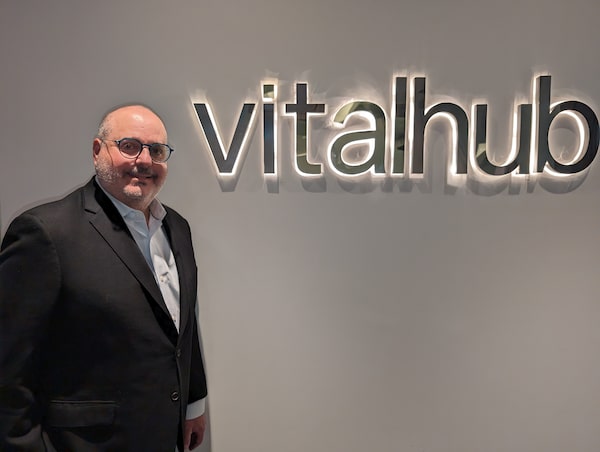
Dan Matlow, the CEO of VitalHub.Handout
VitalHub Corp. VHI-T is a small-cap stock that has delivered healthy returns to shareholders.
Last year, shares of this health-care stock jumped 54 per cent. Returns accelerated in 2024 with the share price rallying nearly 48 per cent in the first quarter. The Street believes further gains are in store for investors. The stock has six unanimous buy recommendations and an average target price of $7.54, according to Refinitiv Eikon.
Driving the positive price momentum are strong and improving company fundamentals. In 2023, VitalHub reported record revenue of $52.5 million, up 31 per cent year-over-year. Annual recurring revenue, or ARR, came in at $44.6 million, rising 23 per cent year-over-year, providing a high percentage of predictable revenue. Adjusted EBITDA (earnings before interest, taxes, depreciation, and amortization) increased 40 per cent year-over-year to over $13 million. The adjusted EBITDA margin hit a record 29 per cent last quarter. The company has a solid balance sheet with no debt.
To learn more about the company, The Globe and Mail recently spoke with president and chief executive officer Dan Matlow.
First off, could you provide a brief overview of the company for readers unfamiliar with VitalHub?
It’s Toronto-based, but we’re an international health-care software IT organization with offerings for government funded health-care only. We offer solutions in three areas, one which we label as patient flow-based solutions. Those are solutions that help health care organizations automate or understand how their patients are flowing across a particular facility or amongst facilities, as well as patient engagement solutions such as appointment solutions or patient portals to help patients navigate more effectively throughout the health-care systems. Then, we have community electronic health-care record systems for community social services-based organizations. Finally, we have what we call work force automation-based solutions.
On the third quarter conference call held in November, you indicated that you were “starting to see some movement” in negotiations with companies you’ve been speaking to for the past few years that you’re interested in potentially acquiring. Last month, you announced a bought deal. Given the size of the recent financing are you looking at making a larger acquisition or multiple tuck-in acquisitions?
We’ve completed 18 acquisitions to-date since inception, since 2017. Our strategy is to grow through M&A and organic growth, and both have been doing very well for us, which is why the financial performance is as strong as it’s been. We are seeing increased activity on both of those avenues, both tuck-ins as well as mid-level acquisitions, and some larger acquisitions. We think we can deploy a lot of that capital throughout 2024, maybe into 2025, for synergistic acquisitions.
So we could see a couple of acquisitions this year?
We’ve already done one this year and we expect to complete another at least three more this year, if not more.
VitalHub has experienced impressive top line growth. In 2020, revenue was just under $14 million. In 2023, it topped $52 million. When do you think you might hit the $100 million mark?
We’re above $60 something million in revenue right now if you look at our last quarter and what we’ve done organically since then with the BookWise acquisition that we just completed.
The guidance I give is $800,000 to $1.5 million of ARR per quarter, annual recurring revenue. We’ve been beating that guidance the last couple of quarters with around $1.9 million per quarter. So it’s growing nicely organically.
To get to $70 million organically with our existing base structure is definitely in sight and to tuck-in another $20, $30 million of revenue from acquisitions, we definitely got visibility into $100 million company coming into the early part of next year.
Let’s discuss potential future agreements. Through an RFP, request for proposal, health-care facilities solicit bids from potential vendors for future projects. How would you characterize RFP activity?
In the community services, we see a lot of RFPs. We’re seeing a very big increase in the community services based in the Canadian marketplace for social services, mental health area, it’s one of those areas that’s a bit of a laggard in digitization. In the U.K. marketplace, they have framework agreements, we’re active in those frameworks.
There’s a lot of funding and a lot of activity in the community services sector in the Canadian marketplace and abroad.
Are you in the RFP process for any potential large contracts with decisions anticipated this year?
There’s one that’s just initiating, which is pretty large that we’re involved with. There’s a lot of $200,000 to $300,000 recurring deals with services, probably like a half a million dollars in revenue deals that we’re bidding on.
Government contracts are typically sticky so customer retention would be high. Is the renewal rate close to 100 per cent?
We budget for about 3 per cent to 5 per cent churn a year.
Have you noticed a change in sales cycles, perhaps they’re becoming longer as health-care facilities want assurances on security measures?
Here’s an example, which I never would have saw even a year or two ago, where you win an RFP and they say you’re the vendor of choice, but before going into contract negotiations, we need to do a security compliance test. And they’re willing to pay for it, but they’re going to get a third party to come in to investigate your security and compliance processes.
Have your systems ever been compromised?
No.
The company has quite a few entrepreneurs. Before purchasing VitalHub in 2016, you founded Medworxx, which was sold in 2015. Sitting on VitalHub’s board of directors are Francis Shen and Tony Shen, former co-founders and co-CEOs of Aastra Technologies Ltd., which was sold to Mitel Networks Corp. Looking at the company’s leadership team, there is a history of growing companies that are later sold. Is there a plan to build VitalHub to a certain level and then sell it?
We’d like to see the company grow, to become like another Descartes or Open Text or something. I think we’re in that growth mode but, you know, once you get it big enough, I’m sure there’s other people out there that we can work with to do things.
The stock price has soared in recent months. Have you noticed a wider interest in the company from potential new investors?
For sure. Every day I’m getting a request from a fund [manager] or someone who wants to learn more. We did that capital raise and there were a lot of funds that really wanted to come in.
How did the raise go? Was it oversubscribed?
Way oversubscribed, literally closed in 20 minutes.
In closing, is there anything you would like to highlight to readers?
We look at making money really in three ways. One is to make accretive acquisitions. I think where the harder part comes in is getting the synergies on the organic growth, which we’ve proven we can do. And then we look for synergistic costs in innovation by using our Colombo development-based group [in Sri Lanka] to do innovation in a cost-effective fashion. All three of those are what we try to do better every day, and the net result is the financials.
This interview has been edited and condensed.
 Jennifer Dowty
Jennifer Dowty